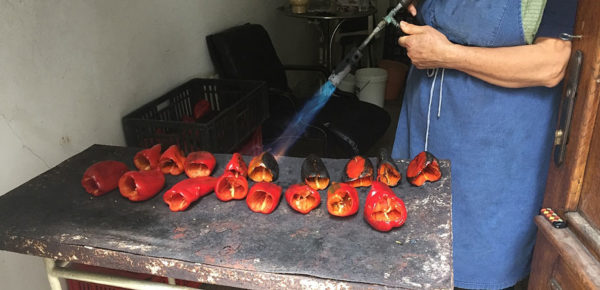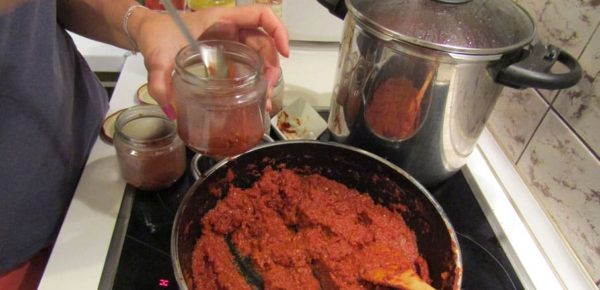Zimnina Making: The Urban Nexus of Food, Water, and Energy in the City of Sofia
Ralitsa Hiteva

In the Bulgarian capital city of Sofia, many people prepare pickled vegetables (zimnina) for the winter months. This widespread practice touches on basic service issues like water and energy supply, as well as food provisioning for the city’s most vulnerable residents, explains Ralitsa Hiteva from the Resilience and Vulnerability at the Urban Nexus of Food, Water, Energy and the Environment (Resnexus) project.
Between June 2017 and March 2018, I peeled and grilled 50 kilos of green and red peppers and tomatoes, and made over 180 jars of “lutenica”. Lutenica is a Bulgarian food term that describes thick and chunky pastes and spreads made of tomatoes, peppers, and eggplant in some cases. Lutenica is one of the most popular forms of so-called “zimnina” in Bulgaria. Zimnina includes any type of food prepared and preserved for consumption in the winter. The widespread practice of zimnina making usually begins in the middle of the summer, with most zimnina making activities taking place at the end of the summer and the beginning of autumn. Zimnina making often involves activities in different locations, with certain parts of the preparations taking place outside the city (sometimes 50-60 km away), and can span over several weeks.
Zimnina making in the Bulgarian capital city of Sofia can be a complex endeavour, involving assemblages of different ingredients and tools in the process of washing, frying, and sterilising the vegetables. It is often energy and water intensive, requires a lot of space and access to transportation, and impacts on the environment. For instance, peppers for lutenica are often roasted using special electric grills, gas blowers or an open fire. Tomatoes are cut, grilled, peeled, and blended, then fried with the peppers on an open fire or an electric hob. Jars of lutenica then need to be boiled until their metal tops sink in and pop—a sure sign that the preservation procedure has been successfully completed.
Ecology of practices within the food-water-energy nexus
The making of zimnina is widely practiced in Sofia among people of all ages, income groups, and education levels. People make zimnina for a number of reasons: they uphold the tradition to preserve food for the winter; because they are convinced that it is cheaper to make your own zimnina than to buy it at the supermarket; because of the superior taste of home made zimnina; because you know exactly what ingredients were used when you make it yourself; or because they need to use up their own produce (tomatoes, peppers).
The material conditions for the process and the surrounding environment determine how zimnina is produced. For example, if urban zimnina makers have access to balconies, they are likely to use pepper grillers and electricity hobs. If they have access to gardens (in the city itself, in peri-urban areas, or in villages where relatives live), they are likely to use gas burners and open fires. Some zimnina makers even make use of spaces around their apartment buildings, lighting fires on the street or grilling peppers in the cool building entrances to avoid the summer heat.

The practice of zimnina making in Sofia is part of a group of related practices (i.e. an ecology of practices) within the urban nexus of food, water, energy, and the environment. For example, it is closely linked with the supply and consumption of energy, and with the existence and accessibility of spaces for urban gardening. Changes to one practice within an ecology can lead to changes in related practices, and related practices can be affected through changes in the surrounding environment. Thinking of practices as part of interrelated dynamic relationships that span beyond a neatly defined series of actions or areas calls for a very different approach to attempting to influence or affect change within cities. The practices of zimnina making, urban gardening and energy provisioning are part of an ecology of practices of sustenance in Sofia.
Currently, policies and urban planning strategies in Sofia that aim to address nexus challenges are limited to technologies for the production of energy from waste and to regulation of water bodies as a source of food (i.e. fish). Nexus interactions between food, water and energy in the city are a black box for city planners and policy makers. They consider zimnina making a small-scale individual practice that is not common in cities anymore, only in villages and peri-urban areas. Just like urban gardening, zimnina making is considered a hobby by city planners and policy makers. As long as zimnina is not being sold, environmental and food safety regulations don’t apply to it. Furthermore, it is considered entirely outside the scope of action and policies trying to address fuel poverty and vulnerability.
Ecologies of practices more visible for vulnerable populations
However, informal practices like zimnina making bring to the surface the connections between food, water, energy, and the environment, particularly for vulnerable urban residents. The Resnexus project1 found that vulnerable groups (including pensioners, single parents, families with more than three children, unemployed and disabled people) in Sofia are heavily dependent on the practice of zimnina making because it allows their food supply to last until the end of winter. For vulnerable groups, zimnina making tends to be more energy intensive, and it is the provisioning of energy that determines how the practice of making zimnina is carried out. When lacking the financial resources to pay for electricity, vulnerable groups tend to use wood for the process.

For many people who live in seasonal or permanent fuel poverty, zimnina making is about sustenance and offers a way of redistributing resources across the year in order to survive the winter months when energy bills are at their highest. For them, urban gardening is the means to grow fruits and vegetables to make zimnina for the winter. The process of zimnina making is water intensive as it requires large quantities of water, first for watering plants, and later for thoroughly cleaning the produce and pots, and for sterilizing the jars. For vulnerable groups the process can be even more intensive (due to excessive watering, washing and boiling), in a bid to produce more and ensure that the zimnina keeps throughout the winter. The water intensity aggravates an already existing problem with water provisioning in the city. The quality of tap water varies significantly across the city. In many areas, it is deemed unsafe because of its brown and muddy colour and “stale taste” from flowing through old pipes. Many people also mistrust the utility companies and municipal regulation and use tap water only for washing dishes, clothes and for personal hygiene. Therefore, drinking water is usually boiled, or people buy bottled mineral water from the shop. Some prefer to buy mineral water for making zimnina or to carry bottles of it from one of the free-flowing mineral springs in the city.
Vulnerable groups also tend to make zimnina entirely or partially out of their own produce (from gardening, collecting, and foraging). It is not unusual that zimnina constitutes a whole meal (without anything to be added to it) and can meet their needs for a day. A one-liter jar can contain enough for breakfast, lunch and dinner for the day. Although many city dwellers who make zimnina don’t sell it, jars of zimnina travel far and are regularly passed on to and exchanged with family, friends, and those in need.
Zimnina making alleviates poverty and fosters new connections among city dwellers
Because of its linkages with the provisioning of food, water and energy, zimnina making can be an innovative urban nexus point of intervention and action in Sofia, and can become part and parcel of alleviating poverty and vulnerability in the city. Examining zimnina making and related practices opens up a new path to understanding urban vulnerability and new pathways for affecting change.
The Resnexus project facilitated a multi-stakeholder workshop in Sofia on the 19th of March 2018, which identified a number of direct actions that can build on the relationships between zimnina making, urban gardening and energy provisioning at different levels:
- recognising that practices of zimnina making and urban gardening are not only hobbies but means of sustenance for vulnerable groups in the city;
- creating environmentally friendly, accessible and shared facilities for zimnina preparation in the city;
- creating volunteering, sharing and needs-based schemes, linking urban gardeners and zimnina makers with related practices such as composting;
- matching up those willing to grow vegetables with people who own or have access to viable green spaces (gardens, plots of land) in the city;
- creating easy ways of identifying and gaining access to viable public green spaces in the city for the development of urban gardens;
- seasonal free/discounted public transport at certain off-peak times to peri-urban areas to facilitate food production and zimnina making.
The key challenges for Sofia’s city planners and policy makers in making use of these connections in a way that facilitates urban resilience and alleviates poverty and vulnerability are:
- the ability to see and understand their nexus nature, which blurs the boundaries between different practices and aspects of urban life (such as use of land, food security, energy and water supply), as well as between what is considered to be a public or private matter; and
- to build partnerships with different interest groups in the city for making these nexus relationships work for those who are most vulnerable.
The municipal agency “Vision for Sofia” is currently developing a long-term strategy for the city, and taking into consideration the urban water-food-energy nexus. The Resnexus project will be informing the process by sharing insights from the ecology of practices of sustenance (urban gardening, zimnina making, and provisioning of energy). However, the extent to which the forthcoming strategy will build on nexus relationships or will aim to address nexus aggravations and vulnerabilities remains to be seen.